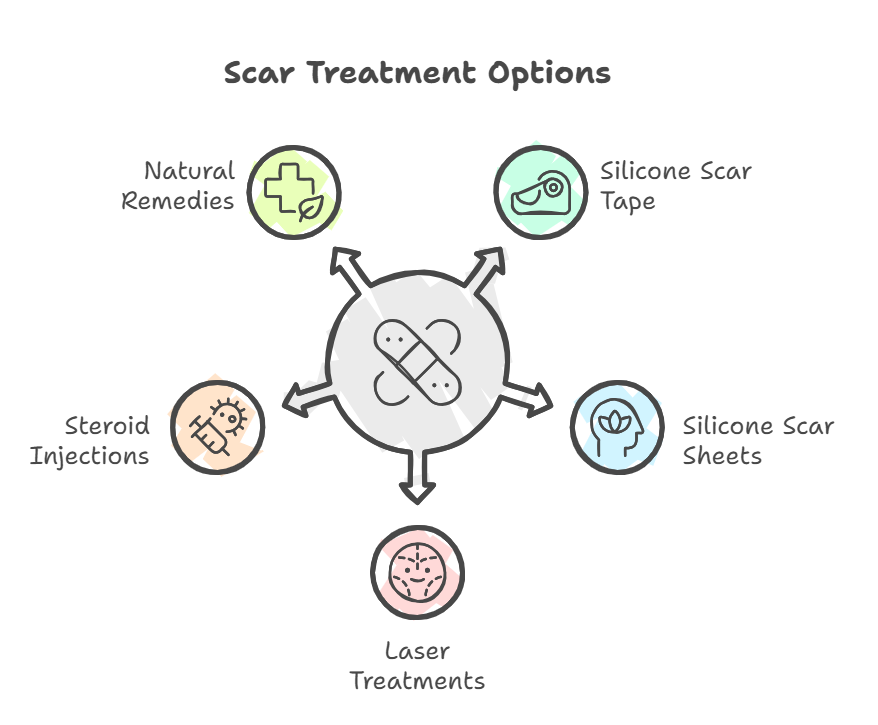Scars are a natural part of healing. Sometimes, we might want help to speed up recovery.
Silicone strips for scars are becoming very popular. No matter how your scar formed—surgery, an accident, or acne—silicone scar tape can help.
“Silicone scar tapes can help to reduce the appearance of existing scars and prevent thicker, raised ones from forming.”
Health.com
Dermatologists and plastic surgeons often suggest silicone-based products. One common option is silicone scar tape, known as silicone scar sheets.
These products form a protective shield over the scar. Research indicates that this barrier hydrates the area and diminishes the scar’s appearance.
Understanding Scar Formation
Scars develop when the dermis, the skin’s deep, thick layer, sustains damage. The body responds by generating new collagen fibers to repair the injury. The appearance and texture of this new skin differ, resulting in a scar.
Scar tape, especially those made with silicone, acts as a barrier. It aids in hydration and controls collagen production1.
A study featured in *Advances in Wound Care* highlighted that silicone scar sheets helps manage excessive collagen buildup.
This control over collagen production prevents the scar from becoming raised or textured. The tape’s steady pressure slowly flattens and softens the scar tissue. Using it regularly for 8 to 12 weeks can help make scars less visible and boost skin renewal.
Types of Scars
Silicone scar tape shows effectiveness across various scar types. The technology in silicone tape helps with these kinds of scars:
- Keloid Scars: These are elevated, often red scars that surpass the initial wound’s boundaries.
- Hypertrophic Scars: Although also raised, these scars remain within the injury’s original confines.
- Atrophic Scars: These scars present as depressions, commonly seen after acne or chickenpox.
- Surgical Scars: These result from surgical procedures, including C-sections and tummy tucks.
The scar’s age influences its reaction to silicone scar tape. Newer scars, still pink or red, usually respond better as they’re in an active healing phase.
Older, white scars might exhibit less noticeable changes, but improvements in texture and softness are still possible with extended use.
How Do Silicone Strips for Scars Work?
Silicone scar tape has been used for scar treatment for years. Many products even say “medical-grade silicone” right in the description2.
These sheets help by hydrating and occluding the scar area. This creates a barrier to reduce transepidermal water loss, basically preventing the skin from drying out.
This hydration helps regulate collagen production. This leads to potentially less scar tissue.
Silicone Scar Sheets: More Than Just Hydration
Beyond moisture, silicone scar tape acts as a barrier. Protecting the fragile skin during recovery and rebuilding.
This kind of silicone strips for scars can be cut and molded. It gives options for people who have various shapes and sizes of scars.
The gentle pressure from the silicone can help. It’s like a comforting hug for your skin, guiding the healing tissues. Many find silicone scar sheets and strips easy and convenient to use.
Using Silicone Scar Tape for Beauty and Cosmetic Procedures
Silicone scar tape is gaining popularity in post-operative care for cosmetic procedures. It helps with the management of scars, potentially leading to improved cosmetic outcomes.
Scar Tape on the Face
Facial skin is delicate, making scar management a key concern. Finding a solution that is both effective and gentle is essential. Silicone scar tape is a great option due to its thin, flexible design, which adapts well to facial contours.
Some tapes are specifically designed for facial use, offering a more discreet and comfortable fit. These options blend seamlessly with the skin, remaining barely visible—even under makeup. For those looking to enhance skin healing, GHK-Cu peptides may also support recovery by promoting collagen production. Learn more about GHK-Cu here.
Scar Tape for the Body, Belly and Fat Removal Scars
Body contouring procedures like liposuction or tummy tucks may result in more noticeable scarring. This happens when the procedure cuts into the skin. Using a scar treatment option, such as silicone strips for scars, can improve outcomes.
Larger silicone scar sheets are more suitable for covering incisions from these procedures. Keeping the areas consistently moisturized benefits the skin long-term.
Consistent moisturizing reduces scar visibility. Silicone strips for scars from surgery might improve skin appearance.
Silicone Scar Sheets and Skin Types
While scar tape is generally safe, skin tone and sensitivity are important considerations. People with sensitive skin or allergies to adhesives should approach silicone scar sheets cautiously.
A patch test is a simple way to check for any adverse reactions before full application.
Individuals with darker complexions might experience hyperpigmentation (darkening) or hypopigmentation (lightening). This typically only happens with irritation or a negative reaction to the tape3.
A dermatologist can offer personalized advice, reducing concerns before starting silicone strips for scars use.
Silicone Scar Sheets vs. Other Options
Silicone gel sheeting might be preferred for people with visible scars because they are transparent. People find them easier to use on visible areas, like the face, compared to gel products.
Other options, like laser treatments or steroid injections, are more invasive. Those options can also require a plastic surgeons to get involved for surgical procedures.
Natural remedies like green tea, onion extracts, or aloe vera may show signs of reducing scarring and preventing infections. Most of the benefits only last for a short time.
Clinical Support for Silicone Scar Sheets
Numerous trials support the use of silicone, in gels or sheeting, for scar treatment. Clinical research often calls it a “first line therapy” for treating scars.

Compared to surgical recommendations, silicone-based products offer a better approach to reducing a scar’s appearance and scar size. Silicone-based products help promote better collagen formation4.
Some studies compare gels versus silicone scar sheets for different scar types. Both are commonly used approaches. In one 2020 study, silicone gel sheets and silicone scar tapes performed the best. This includes the support of using them for a systematic review.
| Treatment | Description | Pros | Cons |
|---|---|---|---|
| Silicone Scar Tape | Adhesive tape with medical-grade silicone | Easy to apply, non-invasive, hydrates skin, regulates collagen | May cause mild skin irritation in some users |
| Silicone Scar Sheets with Gel | Transparent sheets made of silicone | Transparent, suitable for visible areas, hydrates skin | Can be less convenient than tape for some users |
| Laser Treatments | Use of lasers to target scar tissue | Can be effective for treating scars and raised scars | Invasive, can be costly, requires professional treatment |
| Steroid Injections | Injections to reduce inflammation and flatten scars | Can reduce scar size and appearance | Invasive, requires professional treatment, potential side effects |
| Natural Remedies (e.g., Aloe Vera) | Use of natural ingredients to reduce scarring | May provide some relief and prevent infections, Natural | Benefits may be short-lived, less effective than silicone |
Best Practices When Using Scar Tape
Here are some tips to consider.
- Apply on Closed Wounds Only – Never use silicone scar sheets on open wounds. Using ScarSmooth after the wound closes could help. Make sure stitches are gone and any open areas have healed5
- Timing is Key – Start about three weeks after an injury or surgery. Everyone’s skin is different, and response times can vary. For some, it may take up to two years before using the tape.
- Consistent Usage: Use it consistently for best results. Wear it for at least 12 to 23 hours a day. Make sure the area gets some air.
Follow package directions or additional instructions. Some medical-grade silicone sheets should be worn at all times. Cleanse the scar site area thoroughly.
Scar Tape Side Effects and Safety
Using silicone strips for scars for scar management is usually safe. Some people report minor irritation, like rashes and redness, when starting treatment.
Some also experience dryness initially. Other reported issues include maceration, pain, swelling, odor, itching, sweat build-up, or excessive rash.
Make sure to not put the tape on too tight. This can put a lot of tension on the surrounding skin. Also, for any wound care, reach out to your doctor.
Frequently Asked Questions
Does scar tape really work?
Yes, it can help treat scarring. Everyone’s experience is personal.
When is it too late to use silicone strips for scars?
Scar treatments are often recommended about 3 weeks after surgery. Many people use it for several months, and sometimes up to 2 years if the incision is on a certain part of the skin.
For things like acne scars, speak to a dermatologist for the proper solution for scar reduction.
Does taping help scars?
It can minimize scarring. Many studies show better long-term improvements than more invasive procedures like injections or laser treatments. So, look into tape silicone for some options.
Conclusion
There are many ways to treat scars, but the best method varies for each person. To make scars less noticeable, use and time your treatments consistently. Also, be patient. People respond in different ways, and timelines can change. So, keep using silicone strips for scars.
Silicone is considered a great solution in the medical community. Using topical silicone or silicone gel can make a difference. The goal is healed skin.
Small Step, Big Impact
For optimal results, apply silicone scar tape consistently for 8 to 12 weeks, ensuring the skin is clean and dry before each application. Regular use can significantly reduce the appearance of scars and promote healthier skin regeneration.
Listen to this article
This is an AI generated Podcast version of the article.
- https://www.news-medical.net/health/The-Science-Behind-Silicone-Scar-Tape.aspx[↩]
- https://skinovationnc.com/silicone-scar-sheets/[↩]
- https://pmc.ncbi.nlm.nih.gov/articles/PMC10304091/[↩]
- https://www.sciencedirect.com/science/article/pii/S1748681514001739[↩]
- https://www.aad.org/public/diseases/a-z/scars-treatment[↩]


